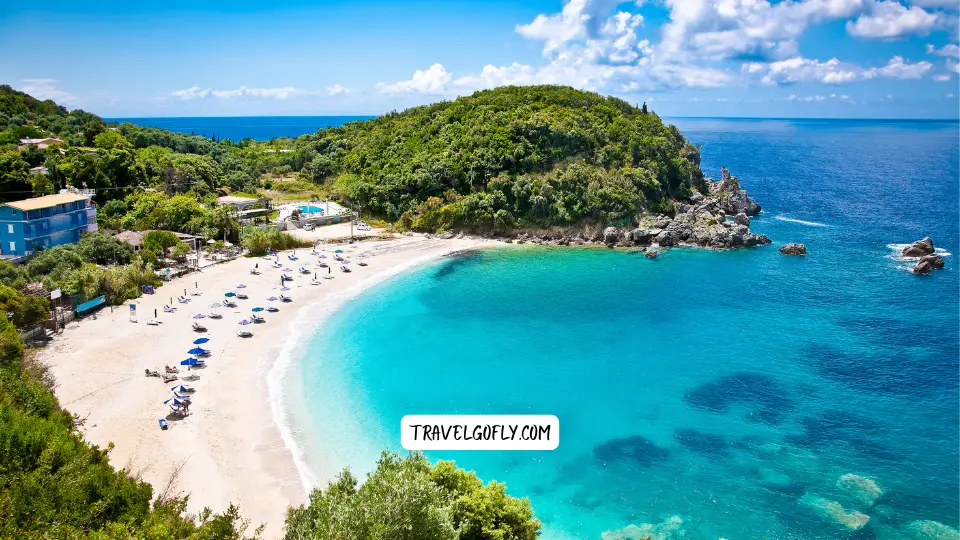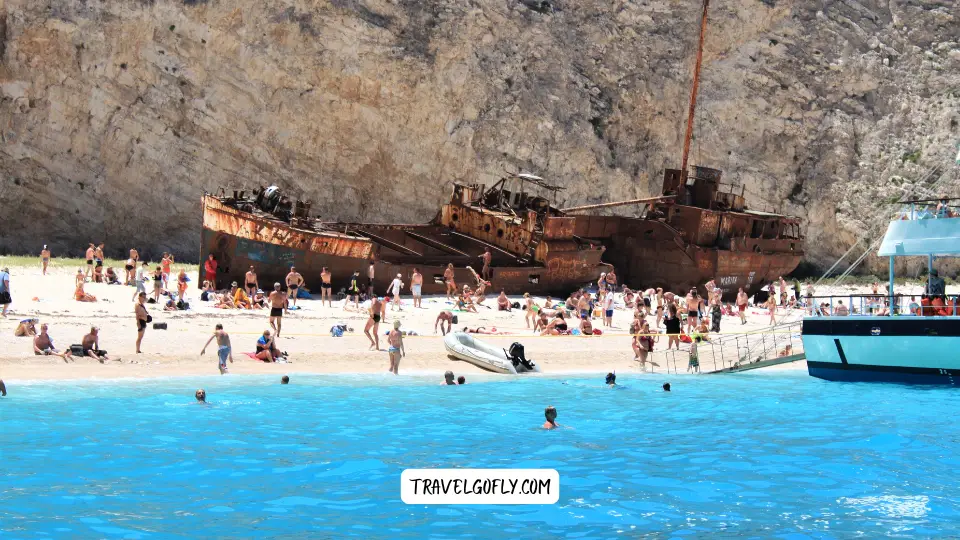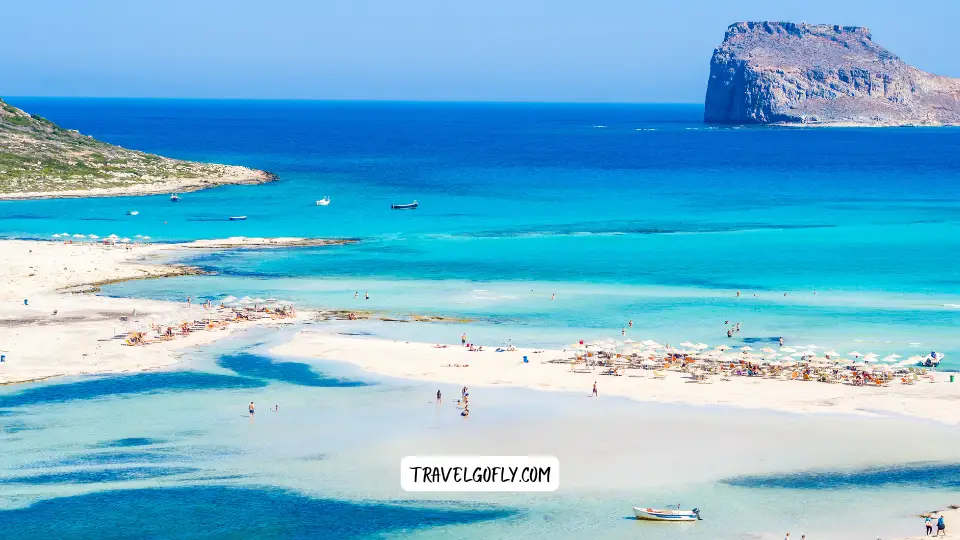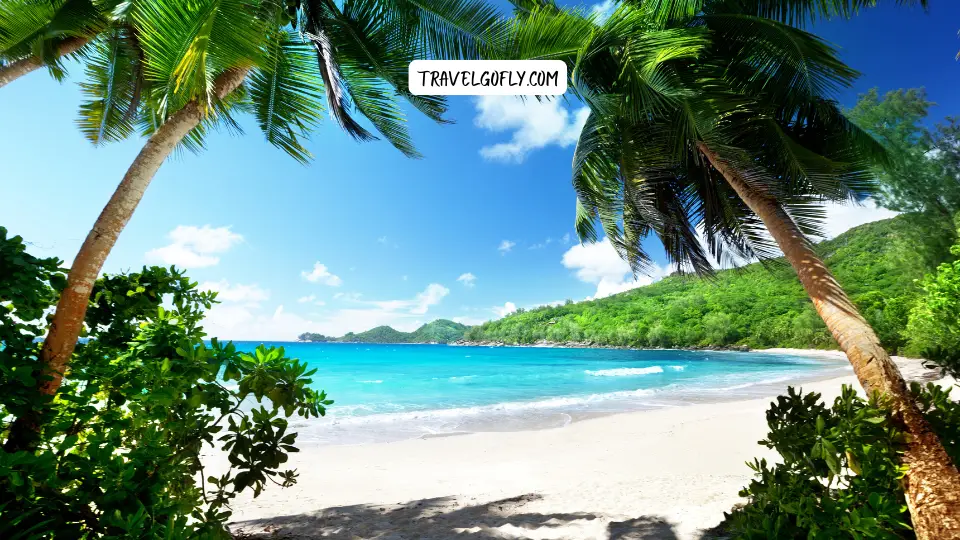Best Greece Beaches are where your dream vacation begins. Imagine crystal-clear turquoise waters gently lapping against powdery white sand, dramatic cliffs framing secluded coves, and the warm Mediterranean sun kissing your skin. Welcome to Greece stunning coastline home to some of the world most breathtaking beaches.
As someone who has spent over a decade exploring the Greek islands and mainland shores, I’ve compiled this comprehensive guide to help you discover the perfect Greek beach experience. Whether you’re planning a family vacation, a romantic getaway, or an adventure-packed trip, Greece offers a beach for every traveler dream.
In this guide, you’ll discover not just the famous postcard beaches, but also hidden gems known mainly to locals. I’ve personally visited each location featured here, evaluating them based on water quality, accessibility, facilities, and that special “wow factor” that makes a beach truly memorable.
Best Beaches in the Cyclades
The Cyclades island group offers some of Greece most iconic beaches, with their distinctive white-and-blue aesthetic.
Sarakiniko Beach, Milos
 Key Info:
Key Info:
- Location: Northern Milos
- Sand Type: Smooth white rocks
- Water: Crystal clear, moderate depth
- Best For: Photography, sunbathing, exploring
- Accessibility: Moderate (short walk from parking)
With its otherworldly moonscape of smooth white volcanic rock formations contrasting against the vibrant blue Aegean Sea, Sarakiniko isn’t your typical beach. This geological wonder creates natural swimming pools and platforms perfect for sunbathing and cliff jumping. The surreal landscape has made it one of the most photographed beaches in Greece.
Insider Tip: Visit early morning (before 9am) to have this photogenic spot nearly to yourself and catch the morning light transforming the white rocks into a golden canvas.
Getting There: From Adamas port in Milos, follow signs north for about 5km. There’s a dedicated parking area, followed by a short walk down to the beach.
Facilities: Limited. No sunbeds or umbrellas, one small canteen in high season. Bring water and supplies.
 Key Info:
Key Info:
- Location: Northwest coast of Zakynthos
- Sand Type: White pebbles and fine sand
- Water: Striking turquoise, deep
- Best For: Photography, swimming, boat trips
- Accessibility: Boat access only
Perhaps Greece most famous beach, Navagio features a rusting shipwreck nestled against towering limestone cliffs on a strip of perfect white sand. The contrast of the abandoned ship against the brilliant blue waters creates a mesmerizing scene that draws visitors from around the world.
Insider Tip: While the view from the observation platform above is spectacular, experiencing the beach from water level is a must. Book an early morning boat tour (departing around 7-8am) to beat the midday crowds.
Getting There: Accessible only by boat from Porto Vromi, Agios Nikolaos, or Cape Skinari. Tours run regularly during summer months.
Facilities: None. Bring water and necessities. No shade except near the cliff edges.
Ionian Island Beach Paradises
The Ionian Islands boast lush green landscapes that cascade down to some of the most beautiful beaches in Greece.
Porto Katsiki, Lefkada
 Key Info:
Key Info:
- Location: Southwest Lefkada
- Sand Type: White pebbles
- Water: Deep blue, crystal clear
- Best For: Swimming, photography, dramatic views
- Accessibility: Moderate (197 steps down from parking)
Dramatically positioned at the base of a concave pale cliff, Porto Katsiki consistently ranks among Europe’s top beaches. The startling contrast between the white beach, vertical cliffs, and electric blue waters creates a scene that seems almost unreal.
Insider Tip: Visit in late afternoon when the sun shifts to illuminate the cliffs with a golden glow. Most tour groups have departed by then, and you’ll have more space to enjoy the beach.
Getting There: From Lefkada Town, drive 45 minutes south following signs to Porto Katsiki. Park at the top of the cliff and descend via the 197 concrete steps.
Facilities: Beach bar, sunbed and umbrella rentals, basic toilets. Limited shade.
Myrtos Beach, Kefalonia
 Key Info:
Key Info:
- Location: Northwest Kefalonia
- Sand Type: White pebbles
- Water: Stunning deep blue to turquoise
- Best For: Photography, swimming, romantic views
- Accessibility: Easy (short walk from parking)
Frequently featured on “Best Beaches in the World” lists, Myrtos is a sweeping arc of brilliant white pebbles nestled between two tall mountains, creating a horseshoe bay of multiple blue hues. The panoramic view from the road above is worth the trip alone.
Insider Tip: The beach appears different throughout the day as the sun changes angle. For photographers, midday offers the most dramatic blue contrast, while sunset bathes the beach in romantic golden light.
Getting There: Located 30km northwest of Argostoli. Well-signposted with a dedicated parking area. Short walk down to the beach.
Facilities: Sunbed and umbrella rentals, small canteen in summer, basic toilets.
Crete Most Beautiful Beaches
As Greece largest island, Crete offers an incredible diversity of stunning beaches, from pink sand wonders to tropical-like lagoons.
Elafonissi Beach, Crete
 Key Info:
Key Info:
- Location: Southwest Crete
- Sand Type: Fine sand with pink hues
- Water: Shallow, crystal clear turquoise
- Best For: Families, photography, wading
- Accessibility: Easy
Elafonissi claim to fame is its subtle pink-tinted sand, created by crushed shells mixed with the white sand. This natural phenomenon, combined with shallow, warm lagoon-like waters, makes it one of the most beautiful beaches in Greece. The beach connects to a small islet that you can wade to through knee-deep water.
Insider Tip: The pink hue is most visible after windy days and is more pronounced at the edges of the water line. Walk to the far end of the beach (eastern side) where fewer people venture for more vivid pink sections.
Getting There: From Chania, drive south approximately 75km (1.5 hours). The road winds through impressive gorges and mountain villages before reaching the parking area.
Facilities: Sunbeds and umbrellas, beach bars, toilets, showers, lifeguards in summer.
Balos Lagoon, Crete
 Key Info:
Key Info:
- Location: Northwest tip of Crete
- Sand Type: White sand with pinkish tints
- Water: Shallow lagoon, varying shades of blue
- Best For: Photography, families, wading
- Accessibility: Moderate (boat or rough road + 20-minute hike)
Often compared to Caribbean beaches, Balos Lagoon features a triangular sandbar creating a shallow, warm lagoon on one side and deeper waters on the other. The panoramic view of this white and turquoise natural formation against the backdrop of Cape Tigani is simply spectacular.
Insider Tip: While boat trips are popular, driving yourself allows you to arrive early (before 10am) or stay late after the tour boats have left. The view during descent is incredible, so keep your camera ready.
Getting There: Either take a boat trip from Kissamos port or drive along a 10km dirt road from Kaliviani, followed by a 20-minute hike down to the beach.
Facilities: Limited. Small canteen during high season, some rental umbrellas. Bring water and supplies if driving.
Family-Friendly Beaches in Greece
When traveling with children, these beaches offer safe swimming, easy access, and good facilities.
Agios Spyridon Beach, Corfu
 Key Info:
Key Info:
- Location: Northeast Corfu
- Sand Type: Fine sand
- Water: Shallow, calm, clear
- Best For: Families with young children
- Accessibility: Very easy
This gently shelving beach creates a perfect environment for families with children of all ages. The shallow water extends far from shore, allowing little ones to play safely while parents relax. Surrounded by lush greenery, this beach offers natural shade and protection from winds.
Insider Tip: The beach has a small freshwater stream emptying into the sea at one end, creating a fun natural play area for kids to build dams and channels.
Getting There: Located about 35km from Corfu Town. Well-signposted, with ample parking directly behind the beach.
Facilities: Excellent. Sunbeds, umbrellas, water sports, beachfront tavernas, toilets, showers, changing rooms.
Voidokilia Beach, Peloponnese
 Key Info:
Key Info:
- Location: Messinia, Southwest Peloponnese
- Sand Type: Fine golden sand
- Water: Shallow, calm, crystal clear
- Best For: Families, nature lovers, photography
- Accessibility: Easy (short walk from parking)
This perfectly semicircular beach forms a stunning natural harbor protected from waves and strong currents. The shallow, clear water is ideal for children, while the surrounding dunes and lagoon offer opportunities for exploration and wildlife spotting.
Insider Tip: After enjoying the beach, take the path up to Nestor’s Cave and the ruins of the Old Navarino Castle for spectacular panoramic views over the beach and lagoon.
Getting There: Located near Pylos. Follow signs to Voidokilia with parking available about 200m from the beach.
Facilities: None. Bring all necessities, including shade, water, and food.
Secluded Beach Escapes
For travelers seeking tranquility away from the crowds, these hidden gems offer peaceful seclusion.
Seychelles Beach, Ikaria
 Key Info:
Key Info:
- Location: Southern Ikaria
- Sand Type: White pebbles and large rocks
- Water: Striking emerald, deep
- Best For: Adventure seekers, photography
- Accessibility: Difficult (30-minute hike down)
Named after the famous archipelago due to its exotic appearance, this hidden cove features massive white boulders contrasting against emerald waters. The challenging access keeps crowds away, rewarding those who make the effort with an almost private paradise.
Insider Tip: Wear proper footwear for the descent, and bring a small backpack with supplies. The rocky seabed makes water shoes advisable for comfortable swimming.
Getting There: From Agios Kirykos, drive toward Magganitis and look for the small sign to “Seychelles.” Park at the end of the dirt road and follow the marked trail down (30 minutes).
Facilities: None. Bring everything you need, including plenty of water.
Kalamitsi Beach, Sithonia, Halkidiki
 Key Info:
Key Info:
- Location: Southern Sithonia peninsula
- Sand Type: Golden sand mixed with small pebbles
- Water: Turquoise, clear
- Best For: Relaxation, snorkeling, privacy
- Accessibility: Moderate (short drive on dirt road)
This serene double bay remains surprisingly uncrowded even in high season. Framed by pine trees that reach almost to the water edge, Kalamitsi offers natural shade and excellent snorkeling opportunities around its rocky edges.
Insider Tip: The left cove is usually less visited. Walk around the small headland to find your own private spot.
Getting There: From Sarti, drive south about 10km, following signs to Kalamitsi. The last stretch is a dirt road to the parking area.
Facilities: Limited. Small taverna at the main beach, some sunbeds. The second cove has no facilities.
How to Choose the Right Greek Beach for You
With thousands of beaches spanning the Greek mainland and islands, finding your perfect match depends on your preferences and priorities. Consider these factors:
For Families with Young Children:
- Look for beaches with shallow, calm waters (Agios Spyridon in Corfu, Elafonissi in Crete)
- Prioritize easy access and nearby facilities
- Consider beaches with natural shade options
- Sandy beaches are typically more comfortable than pebble beaches for children
For Photography Enthusiasts:
- Dramatic settings like Navagio (Zakynthos) or Sarakiniko (Milos) offer unique photo opportunities
- Consider lighting: east-facing beaches shine in morning light, west-facing beaches offer sunset views
- Beaches with distinctive features (pink sand, unusual rock formations) make for compelling images
For Relaxation Seekers:
- Less accessible beaches typically mean fewer crowds
- Islands like Ikaria, Koufonisia, and parts of Milos offer more secluded options
- Consider visiting in shoulder season (May-June or September-October) for more tranquility
For Adventure Lovers:
- Beaches with rock formations are ideal for snorkeling (parts of Milos, Zakynthos)
- Windy beaches in the Cyclades offer excellent windsurfing and kitesurfing
- Consider beaches accessible only by boat or hiking for added adventure
Essential Tips for Visiting Greek Beaches
Timing Matters: Most organized beaches get crowded between 11am-4pm in high season. Early morning or late afternoon visits offer more space and often better light for photos.
Protect Yourself: The Greek sun is intense, especially from June to September. Apply high SPF sunscreen regularly, wear a hat, and seek shade during peak hours.
Beach Etiquette: Nudity is accepted only on designated beaches. Always keep your area clean and take trash with you if bins are full or unavailable.
Water Safety: Be cautious of sea urchins on rocky areas (wear water shoes), and respect warning flags. The Meltemi winds can create strong currents, particularly in the Cyclades.
Sustainable Visits: Choose reef-safe sunscreen, avoid single-use plastics, and never remove sand, shells, or rocks as souvenirs.
Packing Essentials:
- Water shoes (for pebble beaches and rocky entries)
- Portable shade if visiting unorganized beaches
- Reusable water bottle (Greek tap water varies in quality; ask locally)
- Cash for facilities (many beach bars and rentals don’t accept cards)
Frequently Asked Questions
What are the Best Greece Beaches for families?
The most family-friendly beaches in Greece offer safe swimming conditions, easy access, and good facilities. Top choices include Elafonissi Beach in Crete with its shallow waters and pink-tinted sand, Agios Spyridon in Corfu with gentle slopes perfect for small children, and Voidokilia Beach in the Peloponnese with its protected semicircular bay. Look for Blue Flag certified beaches which meet strict safety and cleanliness standards.
When is the best time to visit Greek beaches?
The prime beach season runs from June through September when water temperatures are warmest (72-80°F/22-27°C). For fewer crowds with pleasant conditions, consider late May or early October when temperatures remain comfortable and many facilities are still operating. July and August offer the warmest water but expect more crowds and higher prices.
Which Greek island has the most beautiful beaches?
While beauty is subjective, Milos stands out for its diverse and extraordinary beaches, from the moonscape of Sarakiniko to the multicolored cliffs of Paleochori. Crete offers incredible variety with Elafonissi and Balos Lagoon. Zakynthos is famous for Navagio Beach, while Kefalonia’s Myrtos Beach consistently ranks among Europe’s best. For pink sand experiences, visit Elafonissi (Crete) or certain beaches on Lefkada.
Are there any good beaches near Athens?
Yes! The Athens Riviera stretches south of the city with several excellent beaches within easy reach. Vouliagmeni and Varkiza beaches (about 20-30 minutes from the city center) offer organized facilities with clear water. For a more natural setting, the beaches around Cape Sounion (1-hour drive) provide beautiful views near the Temple of Poseidon. All are accessible by public transportation or taxi.
Which are the best secluded beaches in Greece?
For travelers seeking solitude, consider Kalogeros Beach in Paros (accessible via a dirt track), Livadi Beach in Astypalea (reached by boat or hiking trail), or Agios Ioannis in Gavdos (Greece’s southernmost island). The eastern side of Ikaria offers several remote beaches requiring effort to reach, while northern Amorgos has hidden coves accessible only by boat or hiking paths. Remember that beaches with difficult access typically have no facilities.
Greece coastline offers an incredible variety of beach experiences, from family-friendly shores to secluded natural wonders. This guide covers just a small selection of the country most beautiful beaches – with over 6,000 miles of coastline and more than 6,000 islands and islets (though only 227 are inhabited), Greece beach possibilities are virtually endless.
Have you visited any of these stunning Greek beaches? Which ones are on your bucket list? Share your experiences in the comments below or check out our comprehensive Greece travel guides for more island-hopping inspiration!
